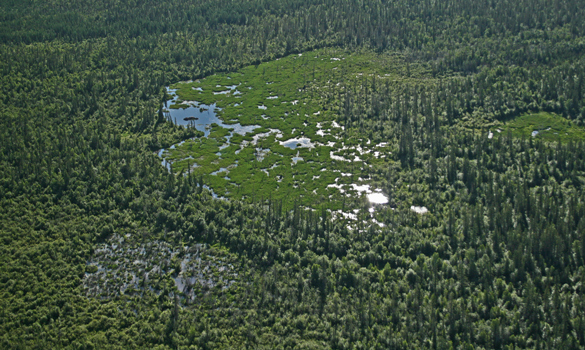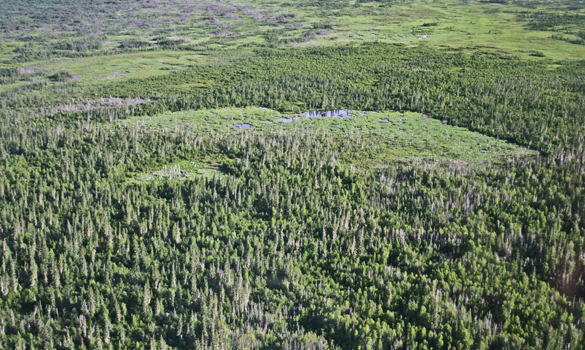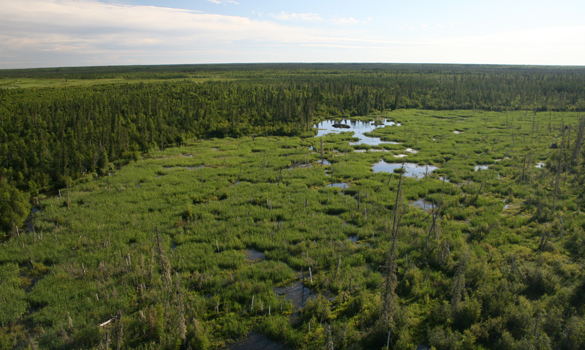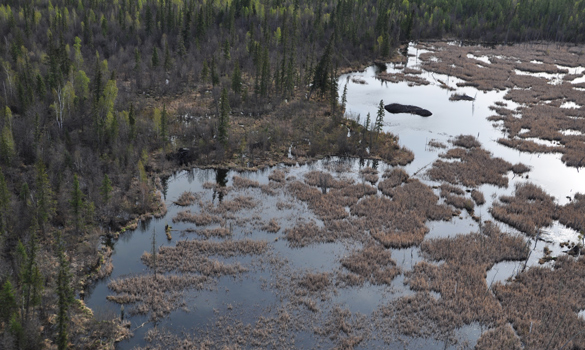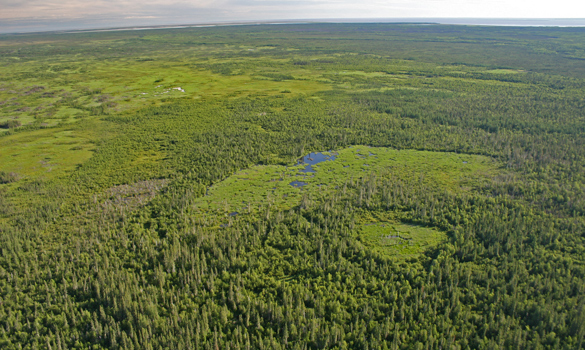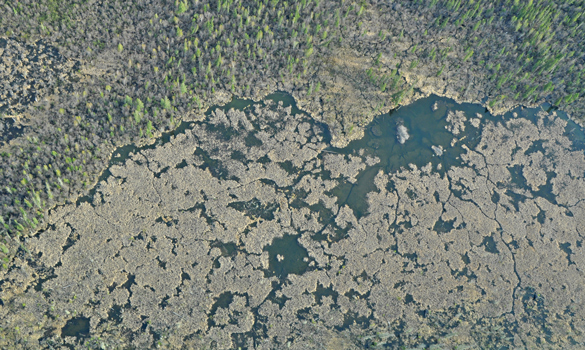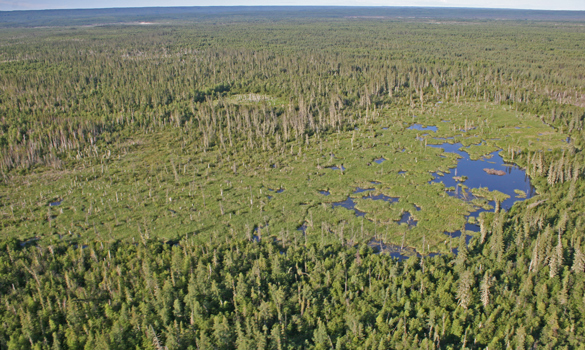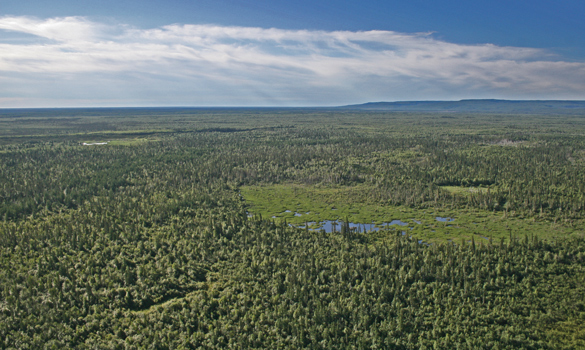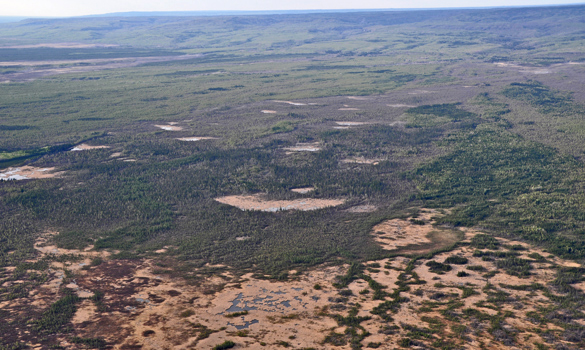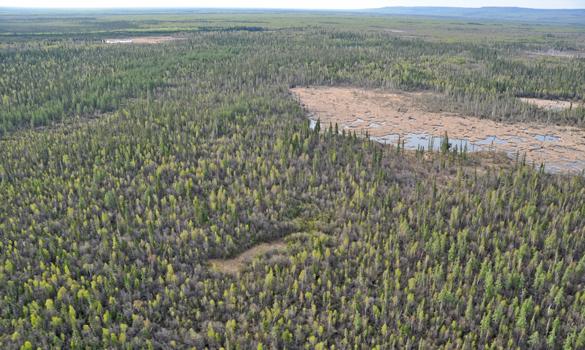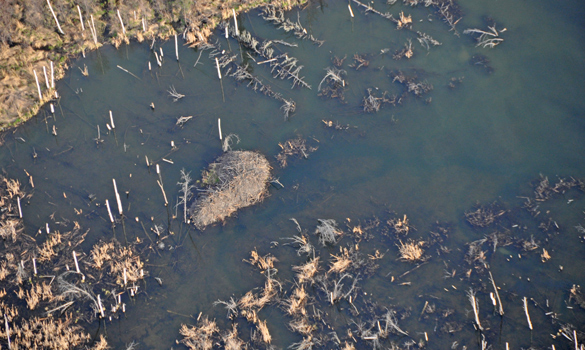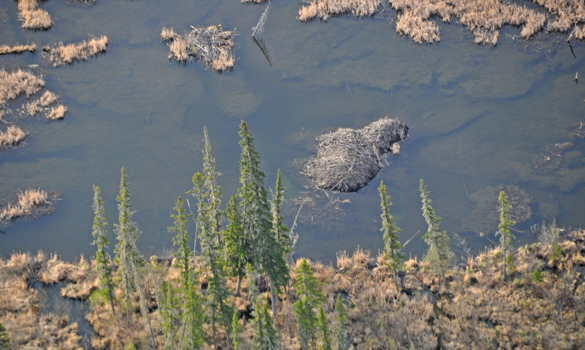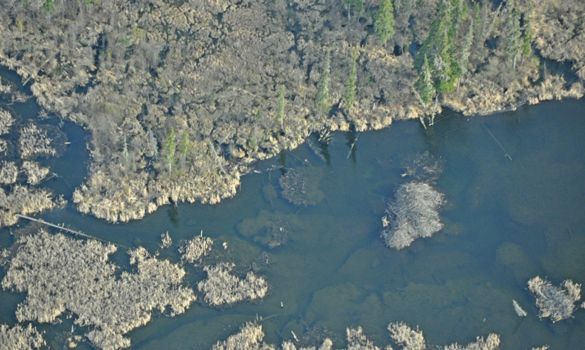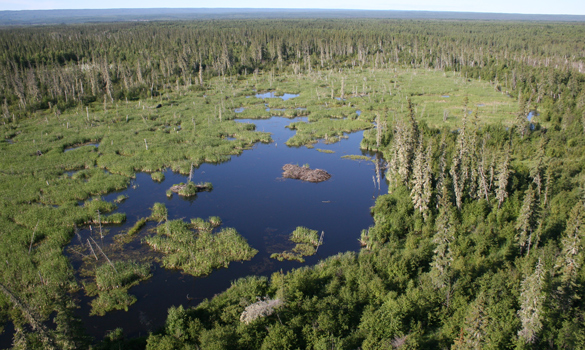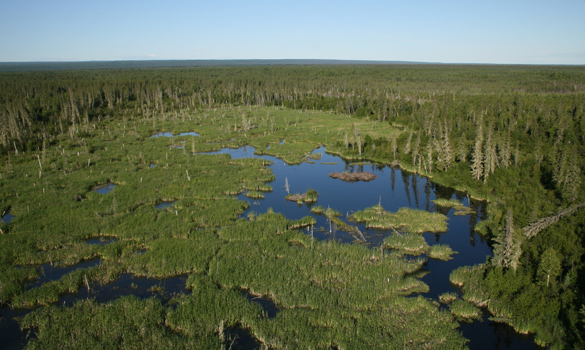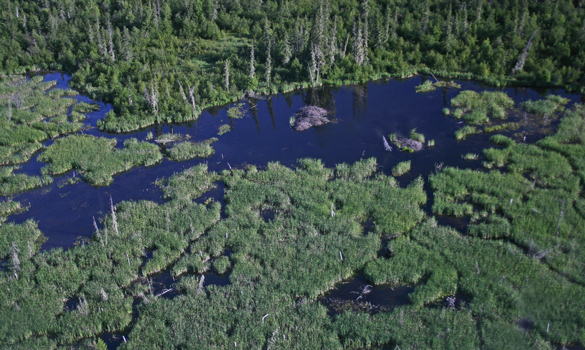Wood Buffalo National Park is the largest national park in Canada. It’s known for wood bison, whooping cranes, and for having one of the largest inland freshwater deltas in the world - the Peace-Athabasca Delta. It is also home to the largest beaver dam in the world.
Where is it?
The world’s largest beaver dam is in the middle of the park - far from any road or trail. To see it, you must either trek for days through tough landscape like wetlands, muskeg and thick boreal forest, or charter a private sightseeing tour.

How big is it?
The world’s largest beaver dam is visible from space in satellite images. It is almost 800 metres long from end-to-end, and holds back run-off water from the Birch Mountains in the southernmost end of Wood Buffalo National Park.
- The front of the actual dam, runs approximately 775 metres in length. The entire perimeter of the dam area is close to 2000 metres.
- The surface area is approximately 70,000 square metres.
- The pond formed by the dam is probably one metre deep, which means it would contain about 70,000 cubic metres of water
Comparisons
- The front end of the dam is about the length of seven football fields.
- A dump truck can carry about 10 cubic yards, so the beaver dam is holding approx. 92,000 dump trucks of water.
- If we thought in terms of hockey rinks, that’s 1600 hockey rinks of water.
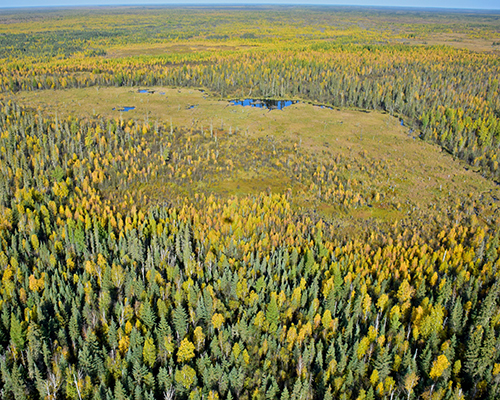
How was it discovered?
Scientists were examining thousands of satellite images searching for the effects of melting permafrost and landscape changes that result from climate change. They found the beaver dam by coincidence during this work, noticing its very large and distinctive horseshoe-shaped shoreline. They notified Parks Canada in 2009, and field staff responded with a site visit by helicopter to take photos and conduct measurements.
What makes it significant?
Beavers build dams in a wide range of boreal forest environments and are well known for engineering and creating their own habitat. What is unique is the size of the dam: where water trickles through the ground and under the forest through a gentle decline from the Birch Mountain uplands to the Birch River as it enters the Peace-Athabasca Delta. Given the size of the structure, it is clearly the work of multiple generations of beavers, reflecting the high quality of the habitat the animals have found in the park.
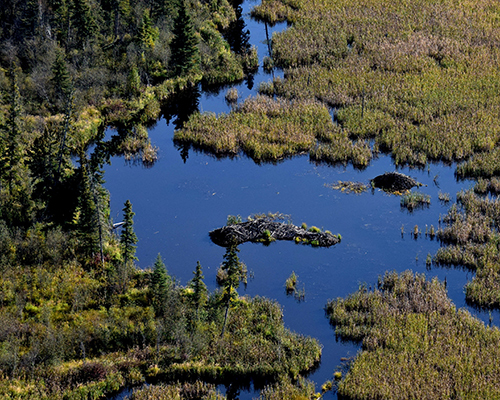
Where’s the river or creek feeding the beaver dam?
The water in the dam is actually not from a single creek or river. Rather this area has unique hydrology – which means that water behaves in interesting ways. High up in the Birch Mountain on the park’s southern border, rainwater and snowmelt at a height of about 700 metres sheds north towards Lake Claire, dropping about 500 metres to get there. This water spreads out and seeps slowly along ancient channels through boggy tracts of boreal forests dominated by willows and black spruce. Even though there is no obvious creek or river, there’s always water flowing into and out of the pond.
How are beavers helpful to their environment?
In places around the world, beaver dams are an important part of watersheds and conservation. Beaver dams help to create wetland habitats for insects, birds, amphibians, fish and other mammals, like moose and muskrat. Beaver dams help retain water on the landscape and to slow the flow of rushing water, like during a flood. When beaver dams are large and long-lasting, they become permanent lakes and ponds on the landscape, just like this one. Overall, wetlands and beaver ponds also provide an important control when it comes to water quality, acting as filters or settling ponds for things like silt and sediments.
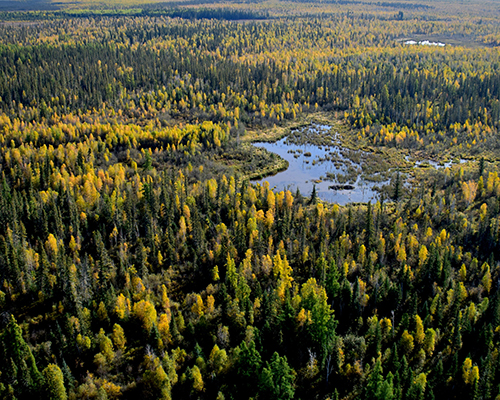
How remote is the dam?
The dam is situated at least 22 kilometres south of the shores of Lake Claire, part of the Peace-Athabasca Delta. The landscape around the beaver dam is challenging and semi-aquatic. No trails, streams or navigable landscape exists in this part of Wood Buffalo National Park. Travel to the dam is not possible by land and landings by helicopter are not permitted. Contact Parks Canada staff to find out more about this special place.
What does Parks Canada do to take care of the beaver dam?
The dam and all natural and cultural resources are protected as part of Wood Buffalo National Park. Parks Canada does yearly monitoring flights to check on the beaver dam and its condition.
Want to know more about Beavers?
If you’d like to know more about this fascinating animal, the Canadian Wildlife Federation has a great website!
Visit: https://www.hww.ca/en/wildlife/mammals/beaver.html for more information
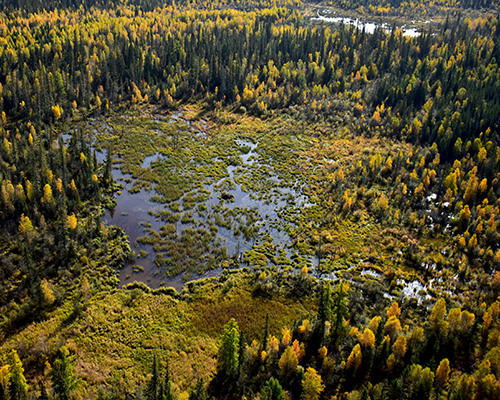
Learning about the world’s largest beaver dam!
Parks Canada staff are happy to provide free, virtual programs about the beaver dam and other wildlife in Wood Buffalo National Park. Inquire by email to ask about booking a program for your school, gathering or non-profit group.
Related links:
How was it discovered?
Scientists were examining thousands of satellite images searching for the effects of melting permafrost and landscape changes that result from climate change. They found the beaver dam by coincidence during this work, noticing its very large and distinctive horseshoe-shaped shoreline. They notified Parks Canada in 2009, and field staff responded with a site visit by helicopter to take photos and conduct measurements.
What makes it significant?
Beavers build dams in a wide range of boreal forest environments and are well known for engineering and creating their own habitat. What is unique is the size of the dam: where water trickles through the ground and under the forest through a gentle decline from the Birch Mountain uplands to the Birch River as it enters the Peace-Athabasca Delta. Given the size of the structure, it is clearly the work of multiple generations of beavers, reflecting the high quality of the habitat the animals have found in the park.

Where’s the river or creek feeding the beaver dam?
The water in the dam is actually not from a single creek or river. Rather this area has unique hydrology – which means that water behaves in interesting ways. High up in the Birch Mountain on the park’s southern border, rainwater and snowmelt at a height of about 700 metres sheds north towards Lake Claire, dropping about 500 metres to get there. This water spreads out and seeps slowly along ancient channels through boggy tracts of boreal forests dominated by willows and black spruce. Even though there is no obvious creek or river, there’s always water flowing into and out of the pond.
How are beavers helpful to their environment?
In places around the world, beaver dams are an important part of watersheds and conservation. Beaver dams help to create wetland habitats for insects, birds, amphibians, fish and other mammals, like moose and muskrat. Beaver dams help retain water on the landscape and to slow the flow of rushing water, like during a flood. When beaver dams are large and long-lasting, they become permanent lakes and ponds on the landscape, just like this one. Overall, wetlands and beaver ponds also provide an important control when it comes to water quality, acting as filters or settling ponds for things like silt and sediments.

How remote is the dam?
The dam is situated at least 22 kilometres south of the shores of Lake Claire, part of the Peace-Athabasca Delta. The landscape around the beaver dam is challenging and semi-aquatic. No trails, streams or navigable landscape exists in this part of Wood Buffalo National Park. Travel to the dam is not possible by land and landings by helicopter are not permitted. Contact Parks Canada staff to find out more about this special place.
What does Parks Canada do to take care of the beaver dam?
The dam and all natural and cultural resources are protected as part of Wood Buffalo National Park. Parks Canada does yearly monitoring flights to check on the beaver dam and its condition.
Want to know more about Beavers?
If you’d like to know more about this fascinating animal, the Canadian Wildlife Federation has a great website!
Visit: https://www.hww.ca/en/wildlife/mammals/beaver.html for more information

Learning about the world’s largest beaver dam!
Parks Canada staff are happy to provide free, virtual programs about the beaver dam and other wildlife in Wood Buffalo National Park. Inquire by email to ask about booking a program for your school, gathering or non-profit group.
Related links:- Date modified :

